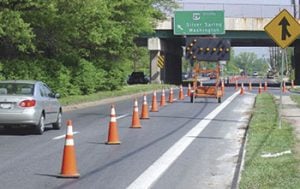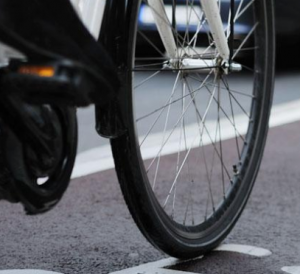In the winter, many of us associate the season with risky driving conditions. However as the season changes, it’s important to note that the summer months have their own unique risks exposures.
Summer is the season for road construction to out-of-town recreational vehicles to drivers pulling boats and campers, motorcycles, bicyclists, and more pedestrians are out and about. These summertime hazards require drivers to be extra attentive.
The National Highway Transportation Safety Administration (NHTSA) is still tallying the 2019 data, but they estimated that 36,120 people would die in motor vehicle traffic crashes. This represents an estimated decrease of about 440 (down 1.2%) from the reported 36,560 fatalities in 2018, even though Vehicle Miles Traveled (VMT) increased by 0.9%.

Highway construction — be careful.
I suspect that 2020 will be one of the safest years in many decades and the fatality rate will decrease significantly because of the stay-at-home orders issued during the COVID-19 pandemic.
As we all now begin to all head back to work and stores, churches, restaurants, and businesses open back up, we need to be aware of some of the top summertime hazards to better keep us all safe.
Hazard No. 1: Summer Construction
Summertime is always the most-traveled season of the year and with the increased traffic on our roads, we will face hazards. However, this is also the time when road construction begins, and traffic delays and detours caused by road construction can make traffic snarls even worse. It is important for drivers to be patient and alert, and to share the road.
To ensure the highest safety in work zones, drivers should:
• Either avoid known work zones or anticipate the delay and allow extra time to get to your destination. Unexpected delays can increase the number of road rage incidents.
• Find an alternate route or adjust their work schedule to avoid hazards or delays.
• Follow signs and, if lanes are being closed, merge early before entering the work zone.
• Expect the unexpected: slow down, increase their following distance, and avoid distractions.
 Keven Moore works in risk management services. He has a bachelor’s degree from the University of Kentucky, a master’s from Eastern Kentucky University and 25-plus years of experience in the safety and insurance profession. He is also an expert witness. He lives in Lexington with his family and works out of both Lexington and Northern Kentucky. Keven can be reached at kmoore@roeding.com
Keven Moore works in risk management services. He has a bachelor’s degree from the University of Kentucky, a master’s from Eastern Kentucky University and 25-plus years of experience in the safety and insurance profession. He is also an expert witness. He lives in Lexington with his family and works out of both Lexington and Northern Kentucky. Keven can be reached at kmoore@roeding.comHazard No. 2: Motorcycles on the Move
As the number of motorcycles on the road increases, so does the opportunity for motorcycle accidents. There are more motorcycles on the road today than ever before with over 8 million motorcycles registered in the United States. The number of registered motorcycles has increased by 100% since 2002, according to the Insurance Institute of Highway Safety.
Motorcyclists also accounted for 14% of all traffic fatalities according to the National Safety Council. Drivers need to make sure that they understand the unique hazards motorcycles present, including the risk of accidents caused by a vehicle turning left in front of a motorcycle.
Drivers should consider the following when sharing the road with motorcycles:
• Be extra aware: Motorcycles can be difficult to see and can vanish in your blind spot. They are also hard to misjudge a motorcycle’s speed.
• Check again and again to make sure a motorcycle is a safe distance from your vehicle.
• Increase your flowing distance when a motorcycle(s) are in front of you at greater distances, as motorcycles can stop more quickly than automobiles.
• Motorcyclists often adjust position within a lane to be seen more easily and to minimize the effects of road debris, passing vehicles, and wind. Understand that motorcyclists adjust lane position for a purpose, not to be reckless or show off or to allow you to share the lane with them.
Hazard No. 3: Bicyclists Can Be Hard to Predict
Like motorcycles, bicycles can be hard to see, and they can be even more vulnerable in a crash. The majority of cyclists who are injured or killed are adults, with 70 percent of those fatalities occurring in urban environments.
In 2018, 857 bicyclists were killed in motor vehicle crashes, a more than 6% increase than the year before. Bicycle rider intentions can be hard to predict if they do not follow traffic rules or use hand signals.

To keep bicyclists safe:
• Understand the local rules. Laws in most states give bicycle riders the same rights as vehicle operators.
• Drivers turning right on red should look to the right and behind to avoid hitting a bicyclist approaching from the right rear. Stop completely and look left-right-left and behind before turning right on red.
• Give bicyclist space — increase your following distance and respect their rights to use the road.
• Look for bicycle riders, especially when opening your door and making right turns at intersections. Look over your shoulder to ensure the way is clear.
• Treat bicycles the same as slow-moving vehicles. Give cyclists 3 feet of clearance when passing. When following a cyclist, give them plenty of space should they change direction or stop.
Hazard No. 4: Pedestrians
Extra daylight and warmer temperatures bring people outside and out onto streets and roadways. This includes joggers, walkers, and homeowners mowing on the edge of the street or roadway.
Pedestrian deaths in 2019 were the highest in 30 years, The Governors Highway Safety Association calculates that there were 6590 pedestrian deaths in 2019, a 5 percent increase from 2018.
Drivers need to be aware that summertime and good weather only increase the number of people that come outside and many of them could be distracted walking by people focused on their mobile devices only increase the dangers of the most vulnerable people on the road: pedestrians.
To ensure the safety of pedestrians, drivers should:
• Watch out for pedestrians at night, especially in urban areas.
• Stop for pedestrians in crosswalks and never pass a vehicle stopped at a crosswalk—pedestrians could be crossing the road.
• Look for pedestrians more than once before turning.
• Watch for pedestrians who might be distracted while walking, as distracted walking has been a factor in some incidents.
There are other types of summertime driving risks to consider, which would include recreational drivers who are unfamiliar with local roads. In addition, summer vacationers may be driving overloaded vehicles with obstructed windows, and drivers may be sleep-deprived from longer days and activities that stretch into the night.
Yes, the weather may be much better driving conditions than the winter, this, unfortunately, gives drivers a false sense of safety because summertime driving can be equally as hazardous.
Be Safe My Friends






















This can be helpful but also very distracting especially for the people on the roads.